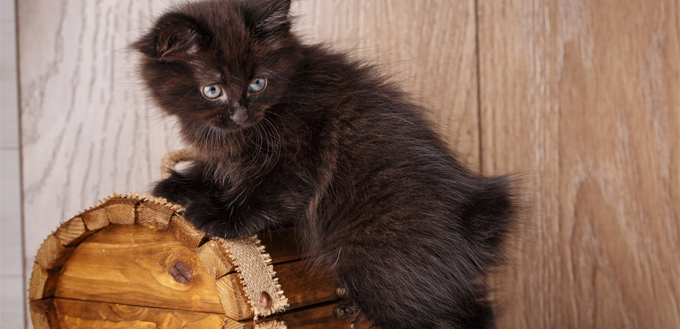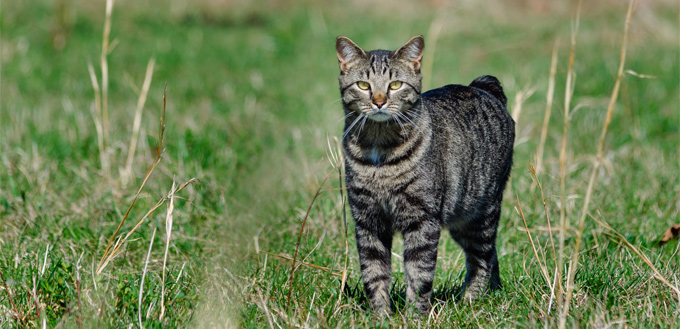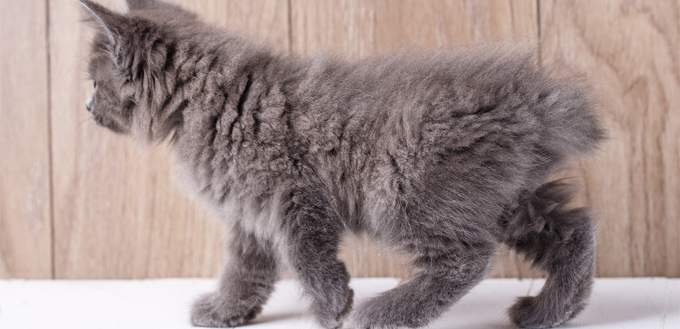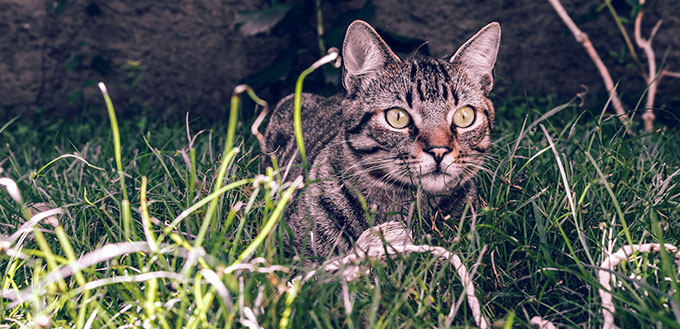The Manx cat got its name due to being native to the Isle of Man. In fact, the Manx is the Isle of Man’s national symbol and can often be seen on its flags. On the island, they became notorious for being excellent at catching mice so their popularity soared. They are instantly recognizable thanks to having no tail or at the very least a very short one that is almost invisible under the rest of its fur on its body. Their walk is also very different to many other cat breeds – they do not have the stealth moves that most cats have and love to jump or hop.
They are now much-loved creatures around the world. This is a guide to the breed if you are thinking about purchasing a Manx so that you get to know its important characteristics and any other facts that will help would be purchasers make an informed decision as to whether the breed is right for them or not.

History of the Manx Cat
As previously mentioned, the Manx cat hails from the Isle of Man. They are one of the world’s oldest breeds. Their popularity first increased when they were used to hunt out mice and rats on ships where sailors wanted to control the number of pests on board. It is sometimes thought that the Manx actually may have come to the Isle of Man aboard a ship from mainland England, though this fact is yet to be confirmed.
Originally named Manks, the spelling of this famous breed slowly changed over the years until it finally became known as the Manx world over. If it is ever crossed with any other type of breed, it can be seen that the gene that predetermines the Manx’s lack of tail is the dominant gene, so that most litters of Manx descendants have little to no tails when born. In times gone by, when biology was less well understood, it was sometimes believed that simply by being in close proximity to a cat, a Manx would influence them to have tailless offspring, such was their perceived power. Some even once thought that the Manx had a lack of tail owing to have been cross-bred with rabbits, which was also a way of explaining their very different gait. They are often seen to hop as bunnies do.
Nowadays, the Manx simply makes a great household pet – regardless of where they came from or whether a home is in need of pest control to keep the numbers of rats and mice down. Due to being prolific hunters, they are well suited to being in the country, in particular on farms, though they are happy enough wherever their owners are. They are endearing creatures with some unique characteristics for a cat.
Quick Facts About the Manx Cat

- It was a genetic mutation that caused its lack of tail
As alluded to earlier, the Manx has a lack of tail that was once thought to have come about due to being bred with a rabbit. However, it is now known that its lack of tail is in fact caused by a genetic mutation. The reason the Manx is so common to the Isle of Man is that the small island had a small cat population and so when coupled with the fact that the tailless gene is dominant, the Manx soon began to dominate over all over cat breeds on the Island. It is now seen on the island’s stamps and currency, and local business often uses it within their logos.
- The first cat show in the world had a manx
Cat shows may sound pretty commonplace these days, but there had to be a first. And it was at the first cat show in England in the late 19th century that saw many breeds partake, including the Manx. It is such an old breed that when the Cat Fanciers’ Association or the CFA was founded and started the largest record of pedigree cats, the Manx was one of the first breeds listed. Not bad for a cat that suffers from a profound genetic mutation causing it to have no tail!
- Manxes can have a wide range of patterns and colorings
The CFA allows the Manx to have a wide range of patterns and colorings for it still to be considered a pedigree example of the breed. This means that Manx can be seen in red, blue, black, white or shades of silver. What the CFA does not allow are the more unusual colors like lavender or chocolate. They believe this means they have been crossbred.
The association also takes note of their eyes and allows these beautiful cats to have eyes in shades of hazel, copper, gold, green, blue or even odd-eyed at times.
When born, Manx kittens are often seen in tabby or tortoiseshell colorings.
- Their tails vary in length
The Manx is known to be the breed of cat with no tail, however, this is not strictly true. The Manx’s tail can actually vary in length. This is because the gene that causes the genetic anomaly is thought to be incomplete. This is why sometimes a Manx can still be a Manx even though they have full-length tails. In fact, within one litter, tail lengths can vary from one kitten to another.
To allow for this, the Manx is then categorized according to its tail lengths. If a Manx has no tail at all, they are referred to as rumpy. If a kitten is born with just a very short stump where a tail is usually seen, they are known as stumpy. Those that are born with a full length tail are known as longy.
The CFA will only allow Manx cats that are seen to be rumpy to enter a championship cat show.
However, all the tail length Manxes are still bred as it is known that this will strengthen the breed as a whole as opposed to encouraging genetic weaknesses due to a smaller gene pool.
- The tailless gene is known as the lethal gene
Sadly, if a kitten inherits the tailless gene from both its parents, it is more than likely to pass away before it is even born owing to the weakness that it can cause. This is why it is often known as the lethal gene in cat breeding circles.

Things You Should Know About the Manx Cat Breed
If you are contemplating buying a Manx cat for either your home or farm, read through the following items first to ensure that the breed is suitable for you and that you can meet its needs too. Bearing this in mind, we look at the health, temperament, care, feeding and grooming requirements of this curious, hopping, tailless breed.
Health
Owners of a Manx can expect their cat to live anything between 8 years and up to 14 years of age. This is easily achievable for the breed if they are fed well and given the right care and attention than any other Manx cat needs.
They do, however, owing to being an old breed, suffer from a number of health issues that are hereditary. You can check with your breeder as to whether they have seen past litters suffer from the following in the past:
- Sacrococcygeal Dysgenesis
- Megacolon
- Rump fold intertrigo
- Corneal dystrophy
- Manx Syndrome – this is a syndrome caused by mass in breeding.
- Arthritis
- Kinked short tails – while this condition is rare, it does happen and is when a cat’s tail does not develop fully. Additionally, reputable breeders will never mate two Manx cats that are both tailless due to the increased risk of miscarriage. Similarly, breeders should never try to mate two Manx that has tails.
Feeding
Like with most breeds, when you buy a Manx kitten, it is imperative to try to stick to the breeder’s original feeding schedule so that your new kitten should not suffer from an upset stomach. If you change their diet, or the routine of their diet too quickly, your new little cat is likely to have their digestive system irritated which can be painful and stressful for them.
Bearing this in mind, if you need to change their diet or the feeding schedule they were on to fit in with your own routine, try to do so as slowly and gradually as possible. If this does cause their stomach to be upset, try to switch back to what you were doing when their stomach could cope.
In fact, many breeders will recommend that a Manx remains on kitten food for the first year of its life as it often contains more protein. This protein helps their bones develop properly. Seek your breeder’s or your vet’s advice if you are unsure of anything.
When your Manx matures, they are not known to be awkward or particularly fussy dieters, but you should still try to feed them the best quality diet you can afford. This will help maintain their health and wellbeing to the optimal level possible. Another good idea is to feed your cat little and often. This is especially true of much older cats.
Lastly, it is important to remember, as with all cats, that their being overweight can lead them to suffer from other health issues that could otherwise be prevented.
Care and Grooming
The Manx cat, as with all cat breeds, will need to be groomed regularly so that their coats are kept in the best condition possible. This means that their skin also remains healthy and free from any infections that can cause pain or further issues. To help keep their skin and coat in top condition, as mentioned previously, their food should be the best quality their owner can afford so that it has a nutritionally balanced diet throughout its life.
Its coat is short, which makes grooming it low maintenance, despite the need to do it regularly. All it really needs is to be brushed once a week and then wiped down with a soft leather cloth afterward to keep its coat nice and shiny. Good pet stores will sell these. Look out for ones made of chamois leather as they are the best. Like all cats, come Spring and Autumn, owners will do well to groom their Manx a little more as this is when they molt the most.
Whilst grooming your cat, it is a good opportunity to ensure that its ears are clean and clear too. This means ensuring that there is the minimal waxy build-up that can cause them pain if it leads to an infection. Ear infections are costly and painful for cats so prevention is key. Keep an eye out for ear mites too as these can also plague any breed of cat.

Related Post: Best Cat Ear Cleaner
Temperament
The temperament of the Manx is seen to be one of the most outgoing and lively of cats going. Whilst they can be shy around total strangers, they are also incredibly sociable when they are relaxed and love nothing more than to shower their owner with affectionate cuddles.
They are an intelligent breed that will enjoy being played with as much as an owner can take when its Manx is awake. They are not a territorial breed and are a placid breed of cat who is not known to ever get into any form of catfight owing to their hatred of confrontation. Their intelligence means that they can quickly figure out how to carry around their own cat toys to play with or even how to open doors – so be wary of any food that is kept in cupboards that a Manx could get to and open.
They having a loving nature and are quick to form bonds with a family, but often do so mostly with the person that regularly feeds it and plays with it most frequently. They are even known to be a talkative breed who likes to talk to other members of its pack.
Given their ability to jump, they like to hop and leap quite high owing to their energetic nature and strong back legs. They are known to exhibit this kitten like behavior for a long time in its life and are often said to mature slowly.
This is one of the reasons they are such a popular breed. They are always fun to be around and families always love to have them as a companion.
More Pet Product Reviews
Heated Cat Beds
Cat Collars
Cat Costumes
Cat Doors
Laser Pointers for Cats
Cat Litter Boxes
Cat Condos for Kitties
Cat Window Perches
Cat Litter
Interactive Cat Toys
Sources:
- Patty Rasmussen, Why Don’t Manx Cats Have Tails?, HowStuffWorks
- Manx, VCA Hospitals






